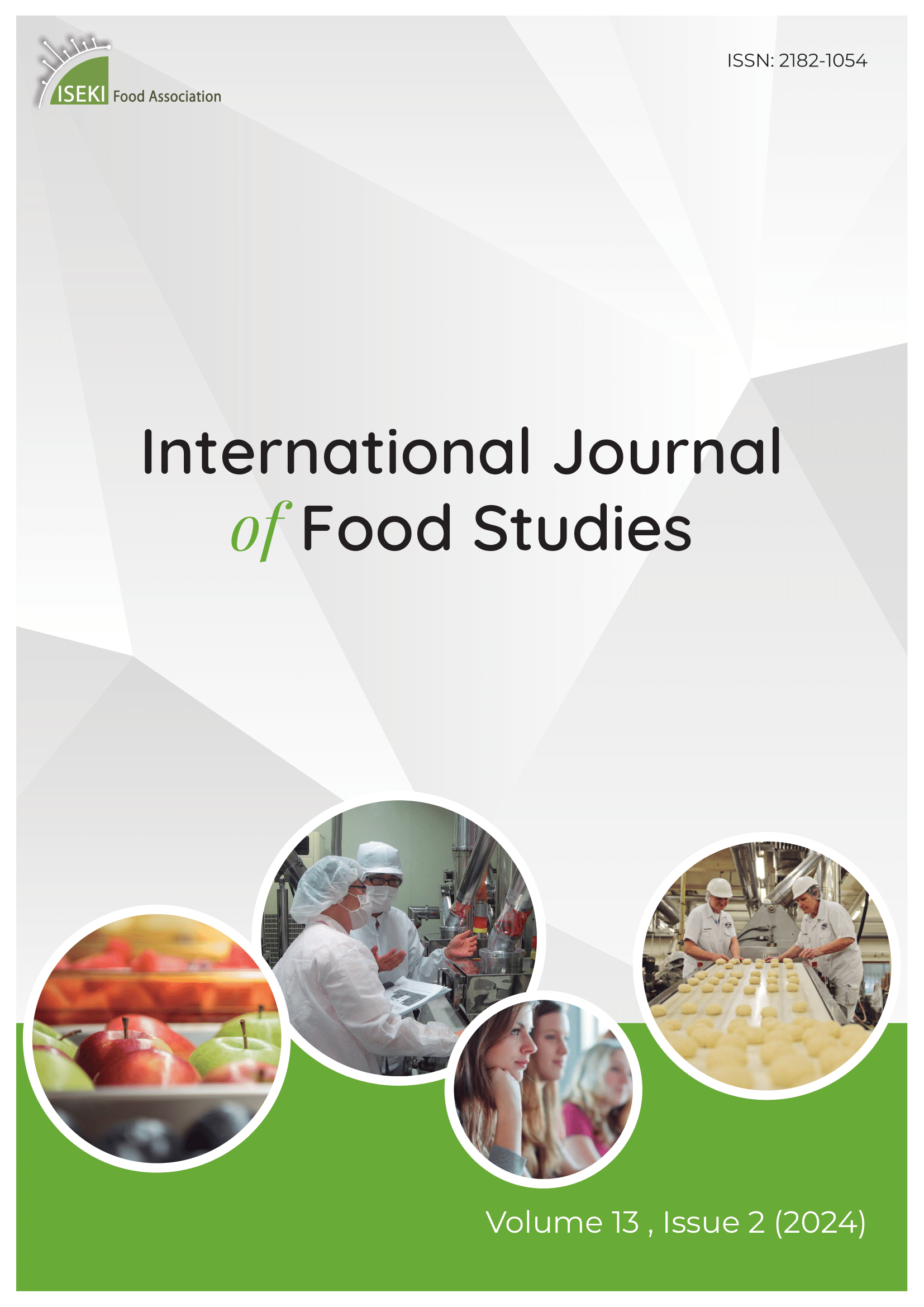Current issue

Volume 13, Issue 2, 2024
Online ISSN: 2182-1054
Volume 13 , Issue 2, (2024)
Published: 18.10.2024.
Open Access
All issues
Contents
01.12.2012.
Professional paper
Antioxidants, their properties, uses in food products and their legal implications
Oxidation decreases consumer acceptability of food by changing its organoleptic properties, destroying essential nutrients and producing toxic compounds. Antioxidants delay oxidation of lipids in foods as well in human systems. Studies reveal that synthetic antioxidants may trigger diseases in human when consumed over a certain concentration. The toxicological effects of synthetic food antioxidants have been the focus of controversy in recent years. There is scope to use natural antioxidants, present in many components of food and plant sources, as a preservative. In this review different synthetic and natural antioxidants present in various foods, reactions with food and the biological system, extraction techniques and their pitfalls as well as legal implication are discussed.
Indrajit D. Thorat, Dipali D. Jagtap, Debabandya Mohapatra, D. C. Joshi, R. F. Sutar, S. S. Kapdi
01.12.2012.
Professional paper
Optimization of the Extraction of Antioxidants and Caffeine from Maté (Ilex paraguariensis) Leaves by Response Surface Methodology
Vanessa Graciela Hartwig, Miguel Eduardo Schmalko, Stella Maris Alzamora, Luis Alberto Brumovsky
01.12.2012.
Professional paper
Effect of Biopreservatives on Storage Life of Papaya (Carica papaya L.)
In this experiment the effect on post-harvest preservation of papaya (Carica papaya L.) fruit coated with either Aloe gel (AG; 100%) or papaya leaf extract with Aloe gel (PLEAG; 1:1) was studied. To evaluate the role of coating on ripening behavior and quality of papaya the uncoated and coated fruits were stored and ripened at room temperature (25 °C-29 °C) and 82-84% relative humidity. Physico-chemical properties were analyzed at 4 day intervals during the storage period. The incidence of disease attack was also visually observed. The overall results showed the superiority of AG and PLEAG coating in lengthening the shelf-life of papaya fruit compared to controls which showed significant decay from 6th day onward and complete decay within 12 days of storage. The AG and PLEAG coated fruits maintained their shelf life for 12 days and decayed at 16th day. The coated fruits also maintained their color, flavor and firmness up to 12 days of storage. An increase in ascorbic acid content (120.2 mg/100 g) was also found in coated fruits in contrast to the control (59 mg/100 g). Only 27% disease incidence was observed in AG and 13% in PLEAG coated fruits as compared to control (100%) during the storage period. The results of this study show that both AG and PLEAG coatings have excellent potential to be used on fresh produce to maintain quality and extend shelf-life.
Fatema H. Brishti, Jawadul Misir, Ayesha Sarker
18.04.2012.
Professional paper
Effect of antioxidant and optimal antimicrobial mixtures of carvacrol, grape seed extract and chitosan on different spoilage microorganisms and their application as coatings on different food matrices
There is growing interest in the use of natural agents with antimicrobial (AM) and antioxidant (AOX) properties. Optimization of the AM capacity for mixtures containing carvacrol, grape seed extract (GSE) and chitosan, against gram-negative (Pseudomonas aeruginosa), gram-positive bacteria (Staphylococcus aureus, Listeria innocua and Enterococcus faecalis) and yeast (Saccharomyces cerevisiae) at 106 cfu mL-1 was studied. To observe the synergistic or antagonistic effect and find optimal combinations between the three agents, a simplex centroid mixture design was run for each microorganism, combining carvacrol (0-300 ppm, X1), GSE (0-2000 ppm, X2) and chitosan (0-2% w/v, X3). Results of the response surface analysis showed several synergistic effects for all microorganisms. Combinations of 60 ppm-400 ppm-1.2% w/v (carvacrol-GSE-chitosan; optimal AM combination 1, OAMC-1); 9.6 ppm-684 ppm-1.25% w/v (OAMC-2); 90 ppm-160 ppm-1.24% w/v (OAMC-3) were found to be the optimal mixtures for all microorganisms. Radical scavenging activity (RSA) of the same agents was then compared with a standard AOX (butylated hydroxytoluene; BHT) at different concentrations (25, 50 and 100 ppm; as well as the optimal AM concentrations) by the 1,1-diphenyl-2-picrylhydrazyl (DPPH) method. RSA increased in the following order: chitosan< carvacrol< BHT< GSE and for the OAMC: OAMC-2< OAMC-1< OAMC-3. The best RSA (OAMC-3) was applied as a coating in two different food matrices (strawberries and salmon). For strawberries, P. aeruginosa was more sensitive to the action of OAMC-3 than S. cerevisiae. For salmon, S. aureus was more resistant to the action of OAMC-3 than E. faecalis and L. innocua.
Javiera F. Rubilar, Rui M.S. Cruz, Igor Khmelinskii, Margarida Cortez Vieira
01.12.2012.
Professional paper
The impact of cold chain temperature abuses on the quality of frozen strawberries (Fragaria ×ananassa)
The quality of frozen foods can be negatively affected if improper storage and distribution temperatures are allowed. The objective of this study was to investigate the effect of freeze-thaw cycles, which may occur in the cold chain, on colour (Lab, Total Colour Differences (TCD), chroma and hue angle) and vitamin C (ascorbic and dehydroascorbic acids) content of frozen strawberries (Fragaria ×ananassa, Duschesne, cv. Selva). A plan of temperature abuses (TAs) was established, based on a real situation, and applied to frozen strawberries during a four month frozen storage period. The results showed that the lightness (L) was the only parameter that was not significantly affected by range of TAs studied. The colour showed some variation on the parameters a, b, TCD, chroma and hue angle. During TAs, ascorbic acid decreased about 75% and dehydroascorbic acid increased 73%. The non-abused strawberry samples showed better overall appearance than the abused samples.This work contributes to an understanding of the quality changes of frozen strawberries that might occur during frozen storage and cold chain distribution.
Rui Cruz, Margarida Vieira, Cristina Silva
01.12.2012.
Professional paper
Increase of “Umami” and “Kokumi” Compounds in Miso, Fermented Soybeans, by the Addition of Bacterial γ-Glutamyltranspeptidase
Thao Van Ho, Hideyuki Suzuki
01.12.2012.
Professional paper
National Food Safety Systems in the European Union: A Comparative Survey
This paper is a comparative survey of the National Food Safety Systems (NFSS) of the European Union (EU) Member-States (MS) and the Central EU level. The main organizational structures of the NFSS, their legal frameworks, their responsibilities, their experiences, and challenges relating to food safety are discussed. Growing concerns about food safety have led the EU itself, its MS and non-EU countries, which are EU trade-partners, to review and modify their food safety systems. Our study suggests that the EU and 22 out of 27 Member States (MS) have reorganized their NFSS by establishing a single food safety authority or a similar organization on the national or central level. In addition, the study analyzes different approaches towards the establishment of such agencies. Areas where marked differences in approaches were seen included the division of responsibilities for risk assessment (RA), risk management (RM), and risk communication (RC). We found that in 12 Member States, all three areas of activity (RA, RM, and RC) are kept together, whereas in 10 Member States, risk management is functionally or institutionally separate from risk assessment and risk communication. No single ideal model for others to follow for the organization of a food safety authority was observed; however, revised NFSS, either in EU member states or at the EU central level, may be more effective from the previous arrangements, because they provide central supervision, give priority to food control programs, and maintain comprehensive risk analysis as part of their activities.
Andreas Hadjigeorgiou, Elpidoforos S. Soteriades, Anastasios Philalithis, Anna Psaroulaki, Yiannis Tselentis, Achilleas Gikas
18.04.2013.
Original scientific paper
Physical properties of honeys produced in the Northeast of Brazil
The aim of this work was to study the rheological, thermal and some other physical-chemical properties of selected honeys produced in the Northeast of Brazil. Two samples were produced by native “Jandaira” bees (Melipona subnitida) and ten other samples by Africanized bees (Apis mellifera). The samples were analyzed for pH, water activity (aW), soluble solids and water content. Viscosity flow curves were obtained using a rheometer (25ºC, 0-100s-1). Thermal analyses were performed on a differential scanning calorimeter, with heating rate of 10ºC/min (-100 to 100ºC). The water content and the pH of the honey samples varied from 17.2 to 27.9% and from 3.2 to 4.2, respectively, and, the aW of the samples varied from 0.57 to 0.74. Two samples were out of specification with respect to water content, according to Brazilian laws. In relation to rheology, all honey samples showed Newtonian behaviour with no thixotropy or dilatancy. The viscosity varied as an exponential function of the water content. The highest viscosity was obtained for the sample with lower values of water content and aW. Thermograms showed a glass transition (Tg) occurring between -52.4 and -42.6ºC, in the samples produced by Apis mellifera and -67.6 and -57.0ºC for the other samples. A linear relationship was obtained between Tg and water content. In conclusion, the honey viscosity depended on the water content of the product. The higher the water value and therefore the greater the aw, the lower viscosity and Tg of the samples.
Patricia Argemira Costa, Izabel Moraes, Ana Mônica Q.B. Bittante, Paulo José do Amaral Sobral, Catarina A. Gomide, Celso C. Carrer
01.12.2012.
Professional paper
Viability of the microencapsulation of a casein hydrolysate in lipid microparticles of cupuacu butter and stearic acid
Samantha Cristina Pinho, Janaina Costa Da Silva
01.12.2012.
Professional paper
Physical properties of honeys produced in the Northeast of Brazil
Patricia Argemira Costa, Izabel Cristina Freitas Moraes, Ana Mônica Q.B. Bittante, Paulo José do Amaral Sobral, Catarina A. Gomide, Celso C. Carrer











